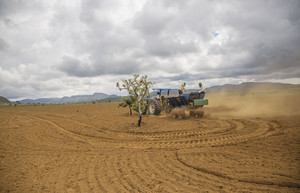
Frenando Tatagiba / ICMBio
A tractor is used for direct seeding of species of trees, shrubs and herbs, in an experiment at Chapada dos Veadeiros National Park in November 2016Frenando Tatagiba / ICMBioIn November 2016, a group of biologists, agronomists and technical specialists, some driving tractors with carts normally used for applying lime to the soil, scattered a soil-seed mixture containing seeds of 80 species of grasses, shrubs and trees native to the Cerrado savannah, in a 96-hectare experimental plot in the municipality of Alto Paraíso, northeastern Goiás State, located in Chapada dos Veadeiros National Park. In March 2017, the plants—by then 10 centimeters high—were beginning to form a green carpet over the area, which had been previously occupied by dense grasses of quick-growing African species that rob space from native vegetation. It is through this activity that the group known as Restaura Cerrado [Restore the Cerrado]—with researchers from the Chico Mendes Institute for Biodiversity Conservation (ICMBio), Embrapa Genetic Resources and Biotechnology, Embrapa Cerrados, and the University of Brasília (UnB)—expects to gather additional evidence showing that direct seeding can truly be a viable choice for restoring the vegetation of that Brazilian natural environment. The planting technique involves the application of seeds already mixed with soil to an area to be restored, which had also been evaluated by another research group in São Paulo.
“We are showing that the Cerrado can indeed be recovered, contrary to earlier assertions that have even come from academic research centers,” says forestry engineer Alexandre Sampaio, a researcher at the National Center for Research and Conservation of the Biodiversity of the Cerrado and Caatinga at ICMBio, who heads the experiment underway since 2012 at Chapada dos Veadeiros. The Cerrado, with an original area spanning two million square kilometers (km2), or 22% of Brazil’s land area, is the country’s second largest natural environment, trailing only the Amazon Region, and it is shrinking continuously. Analyses of satellite images show that the area has contracted by 260,000 km2—double the size of England—as a result of agricultural expansion between 1990 and 2000 (see Pesquisa FAPESP Issue No. 231).
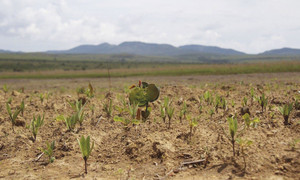
Mariana Siqueira
A jatobá-do-cerrado (largest plant) stands out among the wolf apples and mata-pastos growing in an experimental plot, one month after seedingMariana SiqueiraPrevious studies have indicated that direct seeding could cost about eight times less than planting tree seedlings, the most widely used method of restoring the Cerrado’s original vegetation. Planting seedlings involves first cultivating the plants in nurseries and then transporting them into the field. The problem is that species of this type of native vegetation form very long roots, and growing them in nurseries would require very long bags or tubes. “A five-year-old tree is normally just a few centimeters tall and has roots that are several meters long,” Sampaio observes. He says that other major groups of plants, shrubs and grasses are not grown in nurseries. “Direct seeding of native shrubs and grasses promotes rapid soil occupation and reduces the need for scarification and application of herbicide between tree-planting rows,” says biologist Isabel Belloni Schmidt, a professor at UnB.
In addition to the 96 hectares (1 hectare equals 10,000 square meters) planted in late 2016 through a partnership with a power transmission company that needed to do environmental compensation, the Brasília researchers did another three plantings using direct seeding in smaller areas of Chapada dos Veadeiros between 2012 and 2014, and four in the Federal District. They then spent two and a half years monitoring the growth of 50 native species of trees, 12 shrub species and 13 grass species. After the first year, 36 tree species and five shrub species showed survival rates of over 60%, which is considered satisfactory. Some of the plants achieved 90%, like the cajuí or monkey nut (Anacardium humile), a shrub that reaches a height of up to two meters and bears false fruit—or pseudofruit, which is actually a fleshy peduncle next to the flower—known as caju-do-cerrado. The fruit has red skin and succulent white pulp, and is used in juices, sweets and liqueurs. Native grasses such as Andropogon fastigiatus and Aristida riparia were already covering the area at the end of the first year after planting, as discussed in a paper published in the Brazilian Journal of Botany in March 2017. “There are still about 500 hectares to be recovered in Chapada dos Veadeiros National Park. We’re going to seek partnerships in order to restore them and monitor the existing plants to see how well they prosper. We already know that the better we prepare the soil and remove the exotic grasses, and the more seeds of certain species we use, the better the chances of restoring the Cerrado through direct seeding,” Sampaio says.
GOOD RESULTS WITH TOPSOIL
Another methodology that has yielded good results involves transferring the surface layer of soil, or topsoil, from conservation areas to abandoned pastures and other areas to be populated with native vegetation. This method has been applied successfully in the restoration of Atlantic Forest plants (see Pesquisa FAPESP Issue No. 209). The technique is very simple: prior to the construction of a hydroelectric plant or the establishment of a mining area, for example, a tractor removes a 30- to 40-centimeter layer of soil rich in organic matter, microorganisms, roots and seeds, and transports this normally discarded material to a new area that is to be populated with native vegetation.
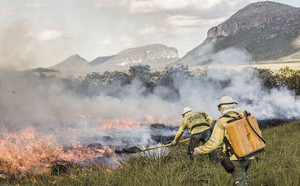
Fernando Tatagiba /ICMBIO
Controlled burning is done six months prior to seeding in Chapada dos Veadeiros National ParkFernando Tatagiba /ICMBIOIn November 2013, ecologist Daniel Vieira, a researcher at Embrapa Genetic Resources and Biotechnology, and UnB biologist Maxmiller Ferreira monitored topsoil removal from a 2-hectare property 10 kilometers (km) from Brasília, to make way for the expansion of a cement factory. The material was then deposited in an abandoned pasture 1.4 km from there, as described in a paper published in the journal Ecological Engineering in June 2017. Six months later, the pieces of trunk and roots that had resprouted accounted for 74% of the tree species in the topsoil source area. After 28 months, there were 51 species of trees, 8 species of lianas, 12 shrub species and 34 herb species, indicating that the process of reestablishing diversity had begun. “It is very important to reuse this soil. “A lot of resprouting goes on in there, and it results in a wide variety of species,” Vieira advises.
He notes that the density, height and extent of the tree canopy indicated that the process of forming a forest similar to the original was accelerating and creating a plant cover. The resulting shade would likely contain the growth of invasive grasses, mostly signalgrass (Urochloa decumbens) and gamba grass (Andropogon gayanus). The tree density was 11 times greater than in Cerrado restoration projects that planted seedlings, which generally establish a predominance of arboreal species, to the neglect of lianas, shrubs and herbs—important components in initial regeneration and the recovery of ecological processes.
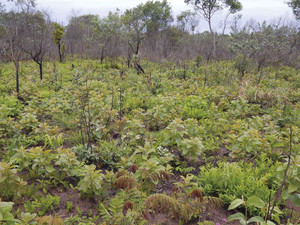
Giselda Durigan /LF
Vegetation resprouts three months after controlled burning in inland São Paulo State…Giselda Durigan /LFThe environmental departments of the Federal District and the state of Mato Grosso have recognized the usefulness of these studies. “Based on the findings of these research studies, we are incorporating topsoil transfer and direct seeding into the environmental compensation regulations,” confirms Raul do Valle, who heads the Legal and Legislative Advisory Office of the Federal District’s environmental departments. Mato Grosso, which has about 60% of the terrain originally covered by Cerrado vegetation, is currently drawing up a decree that will regulate the restoration of degraded areas using these techniques. As in the Federal District, these areas will be monitored. “We’re going to evaluate the ground cover, richness and density of native regenerants [roots, trunks, tubers, etc.], aided by analysis of satellite images, photographs and field surveys,” explains biologist Ligia Nara Vendramin, an environmental analyst for the Mato Grosso State environmental department. In addition, the Restaura Cerrado research group and the Cerrado Seed Network, which promotes seed collection and distributes seeds to forest restoration projects, have published the Guia de restauração do Cerrado [Guide to Cerrado restoration]. The two groups also sponsor courses for rural producers, participate in discussions with public policymakers, and take part in agricultural fairs to disseminate information on restoration techniques among potential users.
Natural regeneration
Forestry engineer Giselda Durigan, along with her team from the Forestry Institute in Assis, São Paulo State, restored the native vegetation of an old pasture in the Assis State Forest using topsoil collected from a Cerrado conservation area in the Santa Bárbara Ecological Station, 150 km away. In another experiment, Durigan and Natashi Pilon, a PhD candidate in ecology at the University of Campinas (Unicamp), were disappointed in the results of a technique called hay transfer. This technique, widely used in Northern Hemisphere countries with a cold or temperate climate, involves scarifying and gathering the herbaceous vegetation and seeds that cover the ground in a conservation area and then spreading this material over the terrain to be restored. Only two species from the original terrain reappeared. “Seeds from the Cerrado germinate more easily when the weather heats up a lot during the day and cools at night,” Durigan observes. “The straw probably keeps the temperature stable and thereby inhibits germination.”
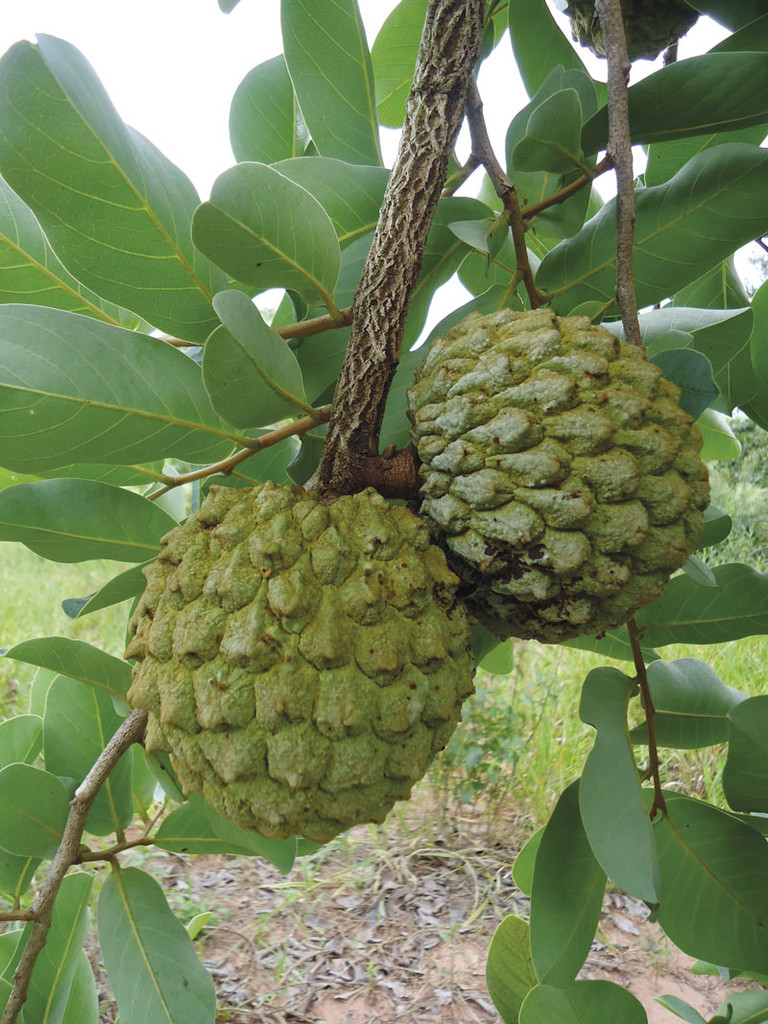
Giselda Durigan /LF
…marolo, a highly valued fruit from the tree of the same name, is typical of the CerradoGiselda Durigan /LFThis type of vegetation often regenerates naturally. In an abandoned pasture on a ranch in Canarana, Mato Grosso, agronomist Mário Cava of São Paulo State University’s (Unesp) Botucatu campus and Durigan’s group recorded 112 tree species, of which only 16 were planted two years earlier. The study was part of an experiment set up by Embrapa Agrosilvopastoral that compared natural regeneration to direct seeding and the planting of seedlings. It was more expensive to plant seedlings, and the technique did not increase density or richness compared to the other approaches. “Direct seeding of native species looks promising initially, but what we found subsequently was low diversity, with only one or two species dominating,” explains the researcher, whose findings differed from those of the experiment in Goiás and the Federal District.
Although natural regeneration is the least costly method, it can be slower and may not always meet expectations. “In some cases, it might indeed be better than planting seedlings, but it’ll take 20 years to become established. And someone who is complying with a court-mandated environmental recovery agreement usually has only a few months or a few years to do the restoration,” says agronomist Pedro Brancalion of the Luiz de Queiroz School of Agriculture at the University of São Paulo (ESALQ-USP). His conclusion is based on an analysis published in November 2016 in the journal Biotropica, which compares 42 programs of companies required to restore areas of the Atlantic Forest, Amazonia, and the transition zones between these environments and the Cerrado, in compliance with the Forest Code or court-mandated agreements.
Signalgrass, an exotic grass, is responsible for some of the difficulty of restoring native vegetation. In a study completed in early 2017, the team from the Forestry Institute observed that signalgrass causes heavy losses among native plants due to its rapid, extensive growth habit. “Native species cannot compete with signalgrass,” Durigan points out. Among the eradication methods evaluated, the one yielding the best results was a combination of controlled burning and subsequent removal of signalgrass shoots that resprout—an approach similar to the one used by Restaura Cerrado. “Herbicides can be effective in killing invasive grasses, but they also kill the natives,” the researcher cautions.

Giselda Durigan /LF
Rare plants of the Cerrado, like the gotas-de-orvalho, can disappear with denser vegetation and lack of light, but they resprout after a fireGiselda Durigan /LFAppeal from the ABC and the SBPC
In an official press release in April 2017, the Brazilian Academy of Sciences (ABC) and the Brazilian Society for the Advancement of Science (SBPC) stressed the urgent need for measures to conserve Brazil’s natural ecosystems, such as implementation of the National Policy for the Recovery of Native Vegetation (Proveg), and they asked the federal and state governments to expand the coverage area of conservation units from the current 7.5% to at least 20% of the original Cerrado terrain. They also asked for active support to traditional and indigenous populations threatened by urban and agricultural expansion, and the expansion of scientific and technological research that leads to better utilization of the natural resources of Brazil’s natural environment. “Low-density livestock-raising in conservation areas, certification, specific legislation, and using only native grasses can be a viable solution,” Durigan comments. In the state of Rio Grande do Sul, after 12 years of negotiation, 24 cattle farmers and environmentalists implemented certified methods of cattle-raising on the native grassland vegetation typical of southern Brazil (see Pesquisa FAPESP Issue No. 240).
Project
Invasion of campo Cerrado by braquiária (Urochloa decumbens): diversity losses and management techniques for restoration (No. 13/24760-4); Grant Mechanism Regular Research Grant; Principal Investigator Giselda Durigan (IF); Investment R$139,392.99.
Scientific articles
BRANCALION, P. H. S. et al. Balancing economic costs and ecological outcomes of passive and active restoration in agricultural landscapes: The case of Brazil. Biotropica. V. 48, No. 6, p. 856–67, 2016.
CAVA, M. G. B. et al. Comparação de técnicas para restauração da vegetação lenhosa de Cerrado em pastagens abandonadas. Hoehnea. V. 43, No. 2, p. 301-15. 2016.
FERREIRA, M. C. et al. Topsoil for restoration: Resprouting of root fragments and germination of pioneers trigger tropical dry forest regeneration. Ecological Engineering. V. 103, p. 1-12. 2017.
PELLIZZARO, K. F. et al. ‘‘Cerrado’’ restoration by direct seeding: Field establishment and initial growth of 75 trees, shrubs and grass species. Brazilian Journal of Botany, p.1-13. 2017.
Book
Sampaio, A. B. et. al. Guia de restauração do Cerrado. V. 1 – Semeadura direta [Guide to Cerrado restoration. V. 1 – Direct seeding]. Universidade de Brasília, Rede de Sementes do Cerrado. 2015.